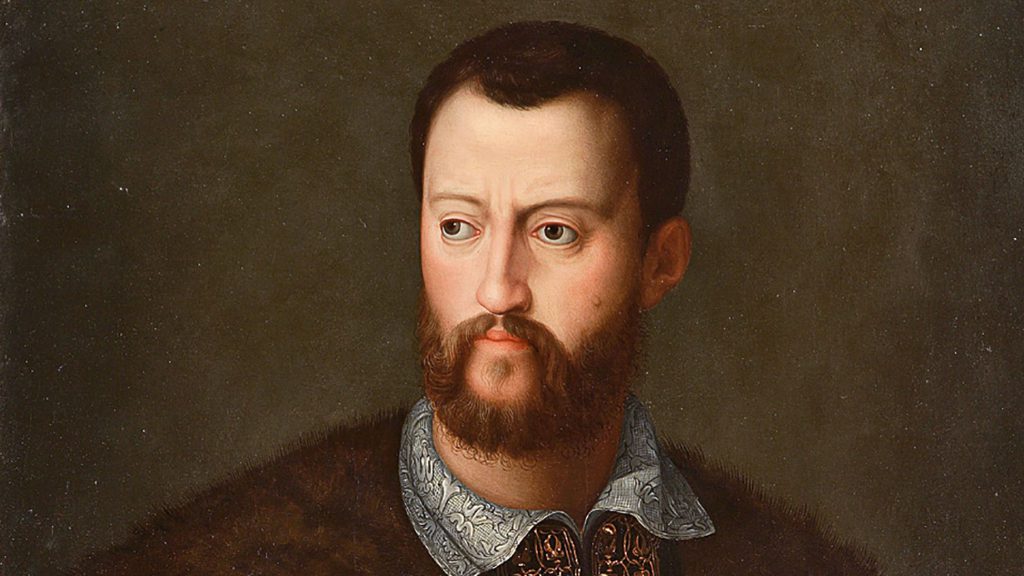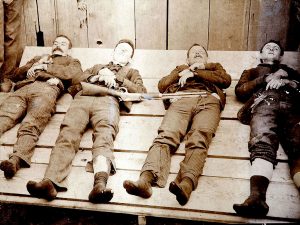Moving quickly, servants load heavy trunks into wagons and on the backs of carriages. Excitement buzzes through the air, along with whispered words, the heavy breathing of horses, and the clinking of golden coins. The harnesses are secured around the horses while a servant rushes to inform the master of the house that their carriage is ready. Soon, silence falls over the servants as they see their master and his mistress exiting the house, bound to return home to Florence. After a year in exile, Cosimo de’ Medici would finally return home to Florence.
————–

As the eldest son and heir of Giovanni de’ Medici, the responsibility for the Medici Bank fell upon Cosimo de’ Medici, who was born on September 27, 1389. Cosimo and his younger brother, Lorenzo, opened branches of the Medici Bank in Naples, Venice, and Rome using a system of independence that allowed each branch to operate independently from the others. Because of the individuality of the branches, the success or failure of a branch did not affect any of the other branches, thus preventing a total and immediate collapse of the Medici Bank in the case of economic downfall. The Rome branch created ties between the Vatican and the Medici family, which Cosimo and Lorenzo used to establish a relationship with the papacy. Through this connection, the Pope began keeping their papal accounts, containing tithes and loans, in the Medici Bank.1
In 1416, Cosimo married Contessina de’ Bardi as a way to link the fortune of the Medici family to the political influence of the Bardi family. The Bardi family, along with the Peruzzi and the Acciaiuoli families, were the most important Florentine bankers before the Medici became wealthier and more popular. They held political influence within the Signoria and the economy of Florence due to their impressive wealth. However, all three families lost their wealth and power in the financial realm around 1343 after they lost an enormous sum during the Hundred Years War. The families had lent money to King Edward III in order to ensure his victory over the French, but King Edward III never repaid the loans, thus losing the financial support that the popular banking families needed in order to maintain their businesses. Due to the loss of funds, the Bardi family lost most of their wealth and status among the elite families of Florence, only maintaining a small amount of political influence. Thus, the marriage between Cosimo de’ Medici and Contessina de’ Bardi gave the Medici family political influence and understanding while providing financial support for the Bardi family. Eventually, the marriage became more than just a contract; Cosimo and Contessina became closer, both in marriage and partnership within the Medici bank. Together, they had two children: Piero de’ Medici and Giovanni de’ Medici.2
As a result of the death of Giovanni de’ Medici in 1429, Cosimo was elected to hold his father’s seat in the Signoria of Florence. The Signoria was the governmental body of the Republic of Florence and consisted of nine members elected from the guilds of Florence. Around the same time as Cosimo’s entrance into the Signoria, Florence began a conflict with the Republic of Lucca. This conflict was supported by another member of the Signoria, Rinaldo Degli Albizzi, who petitioned the Signoria to increase taxes in Florence in order to raise an army to fight against Lucca. Cosimo was faced with a choice: veto the petition to raise taxes and an army because the people could not afford to pay another tax, or alleviate tensions within the Signoria and appease Rinaldo Degli Albizzi by supporting the tax. Against Lorenzo’s wishes, Cosimo voted in Rinaldo’s favor to increase taxes and create an army to use against Lucca. With the tax revenue supporting an army, Rinaldo and his men marched towards Lucca, leaving Florence in the hands of Cosimo.3
With news of repeated military defeats, and with the arrival of a lethal plague reaching Florence, Cosimo attempted to boost the spirit and the economy of the people of Florence by sponsoring and funding the completion of Il Cattedral di Santa Maria del Fiore. But first, Cosimo had to locate and hire an architect competent enough to design and build the dome. He eventually decided on Filippo Brunelleschi, who designed a double dome structure inspired by the dome of the Roman Pantheon. Before Brunelleschi could begin construction of the vast endeavor, however, a question arose that would involve a difficult solution: how would Cosimo pay for the construction of the dome? Cosimo decided to take a huge risk and fund the entire construction through the Medici Bank. Unfounded rumors then spread that Cosimo drew the funds from the unpaid papacy tithes, but these rumors lacked sufficient evidence concerning the allocated funds. Even though the rumors were not supported by evidence, they gained influence and spread throughout Florence, eventually reaching the ear of Rinaldo Degli Albizzi, who was fighting the rebellion in Lucca. After allocating the proper funds, Cosimo financed the construction of the dome while the deadly epidemic and conflict with Lucca continued to devastate Florence.4

After his military defeat in Lucca, Rinaldo Degli Albizzi returned to Florence to witness Cosimo’s increasing popularity among the people. In 1433, Albizzi decided that he had had enough of Cosimo’s power and would find a way to remove Cosimo from Florence as a way to undermine Cosimo’s rising popularity and power. As the plague continued to rampage through Florence, Cosimo and his family left to live in their countryside home as a way to avoid succumbing to the deadly illness. Shortly after arriving, Cosimo received a letter recalling him to Florence for important Signoria business. However, upon his arrival, Cosimo was quickly arrested and thrown in jail based on Rinaldo’s accusations of embezzlement of funds from both the Lucca tax and the papal tithes, as well as the charge of usury. Usury, or lending money at interest as a way of making a profit, was forbidden by the Church and was often viewed as treason, which was punishable by death.5
During his imprisonment and trial, Cosimo feared that his enemies would attempt to assassinate him as an easy method of removing him as a threat. To prevent this, Cosimo bribed the jailer to test each meal to check for poison while also working to defend himself against the accusations brought forth by Rinaldo Degli Albizzi. While Rinaldo was arguing for Cosimo to be put to death for the crime of treason, Cosimo managed to bribe enough members of the Signoria to reduce his sentence to ten years of exile. Cosimo requested that Contessina remained in Florence to maintain appearances and societal standing, while the rest of the family, including Piero’s wife Lucretia, joined Cosimo in exile in Venice. With his plan enacted, Cosimo and the rest of his family left Contessina in Florence and departed for their ten-year exile in Venice, as demanded by the Signoria.5
While in Venice, Cosimo worked with the Signoria of Venice to secure his swift return to Florence, while also providing financial and economic stability to Venice. Cosimo additionally sponsored and commissioned the construction of a beautiful library in Venice as a gift for working with him while in exile. Additionally, Cosimo became romantically involved with a beautiful slave, Maddalena. Over time, Maddalena became Cosimo’s mistress and gave birth to his illegitimate son, Carlo de’ Medici, who would be raised by Contessina as if her own.7
Unfortunately for Florence, Cosimo’s exile and departure from his bank meant Florence’s economy would suffer considerably. The economic downfall, combined with the persistence of the Signoria in Venice, prompted the Signoria of Florence to overturn Cosimo’s exile in favor of economic stability. As a result, Cosimo was able to return home after only a single year of exile, rather than the ten he was supposed to serve. Upon his arrival home in Florence, Cosimo worked quickly to re-establish his bank and popularity with the people of Florence. In order to maintain his power unchallenged, Cosimo and the Signoria of Florence exiled Rinaldo Degli Albizzi and his entire family for the remainder of their lives. One theory, while lacking substantial evidence, proposed that Cosimo went so far as to attempt to assassinate Rinaldo and his son, but that theory was never proven, and Rinaldo died in 1442 while still in exile.8

With his nemesis vanquished, Cosimo’s focus returned to the financial and political well-being of Florence. Until his death, Cosimo worked to support Florence financially through his bank and papal relations, politically through the Signoria and taxation of Florence, and through his financial support of the arts. Cosimo supported many artists financially and contributed numerous gifts to churches, libraries, and the city of Florence itself through sculptures, paintings, and the famous dome of the Cathedral, which was finished in 1471. Sadly, Cosimo did not see the completion of his dome due to his death in 1464, at the age of 74. Posthumously, Cosimo de’ Medici was named Pater Patriae, or “Father of the Fatherland,” because of his financial and political contributions to Florence throughout his lifetime, which continued with his descendants.8
I would like to thank Dr. Whitener, Dr. Moreno, Daniela Duran, and Diane Duesterhoeft for their help in the early stages of this project, particularly in helping me narrow down my topic and with the approach to take in my research. I am also incredibly grateful for all the help in the editing and final phase of the project. And I am most grateful to my family and my friends for their encouragement to help me to see the importance of this project for how it could be helpful and useful to others.
- D.N. Ghosh, “Genesis of High Finance: Case of Medici Bank,” Economic and Political Weekly, 41, no.7 (2006): 542-543. ↵
- Anthony M. Cummings, Partial Genealogy of the Medici Family (New Jersey, Princeton University Press, 2015), 17-18. ↵
- Carlos Jose Hernando Sanchez, Family, Court, and Government in the Toledo-Medici Alliance (Boston, Leiden Pub., 2007), 159. ↵
- Carlos Jose Hernando Sanchez, Family, Court, and Government in the Toledo-Medici Alliance (Boston, Leiden Pub., 2007), 161. ↵
- Global Events: Milestone Events Throughout History, 2014, s.v. “The Rise of the Medici Family.” ↵
- Global Events: Milestone Events Throughout History, 2014, s.v. “The Rise of the Medici Family.” ↵
- “The Medici Family,” The Illustrated Magazine of Art, 2, no. 9 (1853): 177-178. ↵
- Encyclopedia of the Early Modern World, 2004, s.v. “Medici Family,” by Carol M. Bresnahan. ↵
- Encyclopedia of the Early Modern World, 2004, s.v. “Medici Family,” by Carol M. Bresnahan. ↵




19 comments
Desiree Arizmendez
I definitely loved the way you introduced the articles with your first paragraph, it was very grabbing. I was very surprised how it grabbed my attention and kept me going. It was very interesting and informative and I valued knowing about how after Medici’s exile really made the economy suffers. I also really found the fact that he protected himself by making the guard test his food very interesting because I would have not thought about that solution.
Genesis Vera
I had no idea what I was going to read but after the first paragraph, I was captivated. The last sentence of the first paragraph instantly captures the reader and makes them wonder why Cosimo was in exile. You can tell the author really focused on the small details and as a result, made a fantastic informational article.
Alexis Lopez
I had never heard or even learned about Cosimo de’ Medici which made this article more interesting. It was very informative and detailed article! I loved reading about the back story of Cosimo and learning how he grew up and what made him who he was. I liked the fact that Cosimo helped Florence financially through his back and as well as politically. I think it’s sad he wants able to see the completion of his dome because of his death. Overall, I enjoyed reading this article.
Erin Vento
This was a really interesting article! Everything that I knew about the Medicis I learned from the Netflix series, but this was a really cool article about Cosimo specifically! It was really interesting to see how he went from being in charge of the bank, to being a member of the signoria, to being imprisoned and then banished only for him to come back and support the city.
Shriji Lalji
Great story with a happy ending. It was nice to see that Cosimo used his wealth to support the people and development of Florence. In addition, I was not aware of the existence of banks in that time period. However, it was interesting to learn about how they operated within the rules of the church.
Jourdan Carrera
This article talks about, probably what was the height of the Medici bank and what would have been when they were at their height even while in exile. In my opinion Cosmo Medici was almost certainly one of the most influential political figures of the Medici bank and too it to new heights which had never been reached before, both in power, wealth and influence.
Jakob Trevino
This was a fascinating and informative article. I have never heard about Cosimo de’ Medici but after the author had described the idea of this man it was interesting to understand. I thought it was very cool how he was able to protect himself from prison by bribing people.
Cristi
You’ve got the wrong painting. That is Cosimo, the Grand Duke of Tuscany, who was born almost 60 years after Cosimo the Elder.
Maria Obregón
Very interesting and informative article! I had not learned anything about this before, therefore it was great to read this and learn something completely new to me. What I found most interesting was how Cosimo de’ Medici was able to bribe people while in prison, and all to protect himself. I found this interesting because of the fact that they did listen to him and did as told.
Madeline Chandler
Such an interesting and informative article!! I have obviously previously heard of Cosimo de’ Medici, however not any element of this story or to this detail. So very captivating, you really pulled in your audience. I have never heard of this story in Florence of family’s deaths and marriages, so it was so cool to learn about something from history I had not known. I thoroughly enjoyed reading your article. Great job!!
Bailey Godwin
This was a very well written and informative article. Before reading this article, I had no prior knowledge on this topic. It was crazy to me that Cosimo was so worried about being killed that he bribed guards to taste his food before he ate it to prevent himself from being assassinated by poison, considering he was only put in jail based on accusations of one person.